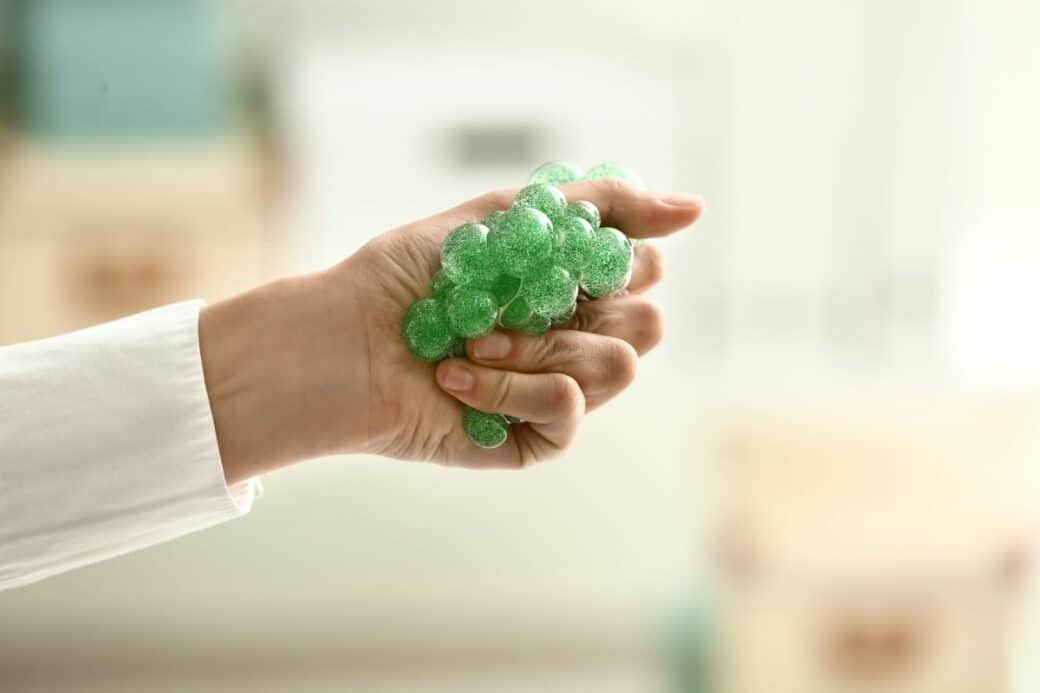Are you someone who relies on stress balls to help you alleviate tension and anxiety? It’s essential to ensure that the stress ball you choose is of high quality and can withstand daily use. In this article, we’ll explore the durability of stress balls and determine whether they are prone to breakage. By examining the factors that contribute to stress ball breakage, you’ll gain insight into how to select a reliable stress ball that will stand the test of time and provide you with the ultimate stress relief experience.

Can Stress Balls Break: Understanding Stress Balls
Stress balls are small, squeezable objects that are designed to help relieve stress and tension. They are usually made of a soft, pliable material that can be easily manipulated and squeezed. The primary purpose of stress balls is to provide an outlet for physical and emotional stress, allowing individuals to release tension and relax.
What are stress balls?
Stress balls are typically small, round objects that fit comfortably in the palm of your hand. They come in a variety of shapes, sizes, and colors, but are usually made from materials that offer a certain level of resistance when squeezed or manipulated. This resistance provides a tactile sensation that can be soothing and calming.
Uses of stress balls
Stress balls have a wide range of uses and can be beneficial in many different situations. They are commonly used as a stress management tool, providing a physical outlet for stress and anxiety. Many people find that squeezing a stress ball helps to relieve tension, reduce anxiety, and promote a sense of calm. Stress balls can also be used as a tool for improving hand strength and dexterity, making them popular among athletes and musicians.
Types of stress balls
There are various types of stress balls available on the market, each with its own unique characteristics. Traditional stress balls are typically made of foam or rubber, offering a soft and squishy texture. Gel-filled stress balls are another popular option, providing a more liquid feel when squeezed. Some stress balls are filled with substances like sand or beads, offering a different tactile experience. Additionally, there are stress balls that come in different shapes, such as animals or objects, allowing for personalized preferences.
Life Span of Stress Balls
The life span of a stress ball can vary depending on several factors. Understanding these factors can help you determine how long your stress ball is likely to last.

Frequency of use
The more often you use a stress ball, the quicker it may wear out. Constant squeezing and manipulation can put stress on the material, causing it to break down over time. If you use your stress ball frequently, you may notice that it loses its shape or becomes less firm.
Quality of the stress ball
The quality of the stress ball can play a significant role in its longevity. Higher-quality stress balls are often made with durable materials that are designed to withstand frequent use. Lower-quality stress balls, on the other hand, maybe more prone to tearing or breaking.
Proper handling of stress balls
How you handle your stress ball can also impact its lifespan. Avoiding sharp objects or excessive force when squeezing can help prevent damage to the material. Additionally, storing your stress ball in a cool, dry place can help preserve its shape and integrity.
Stress Balls Material
The material used in making stress balls can greatly affect their overall quality and durability. Understanding the common materials used in stress balls and their impact on performance is essential.
Common materials used in making stress balls
Foam and rubber are the most common materials used in making stress balls. Foam stress balls are soft, lightweight, and provide a squishy texture. Rubber stress balls, on the other hand, are more resistant and offer a firmer feel when squeezed. Gel-filled stress balls contain a gel-like substance that offers a unique tactile experience. Each material has its own unique benefits and drawbacks, so choosing the right one depends on personal preference and desired sensory experience.
Factors contributing to the quality of materials
The quality of the material used in stress balls can vary greatly. Factors such as density, flexibility, and durability all play a role in determining the overall quality of the material. Higher-quality materials are often more durable, tear-resistant, and can withstand repeated use without losing their shape or effectiveness.
How materials impact the durability of stress balls
The material used in a stress ball directly impacts its durability. Some materials are more prone to tearing or breaking when subjected to frequent use or excessive force. Foam stress balls, for example, may eventually lose their shape or become less resilient over time. Gel-filled stress balls may be more susceptible to leaks or ruptures. Understanding the properties of different materials can help you choose a stress ball that meets your needs and offers long-term durability.
Can Stress Balls Break?
While stress balls are designed to withstand some level of manipulation and squeezing, there are instances when they can break. Understanding the factors that can contribute to the breakage of stress balls is important in preventing accidents and ensuring their longevity.
Instances when stress balls can break
Stress balls can break under certain circumstances. Excessive force or squeezing beyond the recommended limits can cause stress balls to rupture or burst. Sharp objects or rough surfaces can also lead to tears or punctures in the material.
Factors that lead to breaking
The quality of the stress ball’s material and the frequency of use can greatly influence its susceptibility to breaking. Lower-quality stress balls or those made from less durable materials may be more prone to breakage. Similarly, using a stress ball excessively or subjecting it to rough or inappropriate handling can increase the likelihood of it breaking.
Experiences of users
Many users report positive experiences with stress balls, noting that they are generally durable and resistant to breaking. However, there are occasional instances where users have encountered stress balls breaking due to excessive force or wear and tear. It is important to use stress balls within their recommended limitations and handle them with care to avoid any potential breakage.
Quality Indicators of Stress Balls
When looking for a high-quality stress ball, consider several factors that can indicate its overall quality and effectiveness in providing stress relief.
Size of the stress ball
The size of a stress ball can impact its usability and effectiveness. A stress ball that is too small may not provide enough surface area to comfortably grip and squeeze. On the other hand, a stress ball that is too large may be difficult to manipulate effectively. Finding a stress ball that fits comfortably in your hand is important for optimal stress relief.
Weight of the stress ball
The weight of a stress ball can also affect its sensory experience and effectiveness. A stress ball that is too light may not offer enough resistance when squeezed, while a stress ball that is too heavy may cause discomfort or strain. Finding a stress ball with a weight that feels comfortable for you is crucial.
Texture and firmness
The texture and firmness of a stress ball can greatly affect its tactile experience. Some individuals may prefer a stress ball with a soft and squishy texture, while others may prefer a firmer feel. It is essential to choose a stress ball with a texture and firmness that you find pleasing and effective in relieving stress.
Brand reputation
Consider purchasing stress balls from reputable brands with a solid reputation for producing high-quality products. Brands that prioritize customer satisfaction and have positive customer reviews are often a good indication of quality. Researching brands and reading customer feedback can provide insight into the overall quality and durability of the stress balls they offer.
Maintenance of Stress Balls
Proper maintenance and care of stress balls can help extend their lifespan and ensure continued effectiveness in stress relief.
How to properly take care of stress balls
Cleaning stress balls regularly can help remove dirt and debris that may accumulate over time. Most stress balls can be cleaned using mild soap and water. Simply wet a cloth or sponge with soapy water, gently wipe the surface of the stress ball, and rinse thoroughly. It is important to allow the stress ball to dry completely before using or storing it.
Dos and Don’ts in Handling Stress Balls
When using stress balls, it is important to exercise proper handling techniques to prevent damage or breakage. Do avoid using excessive force when squeezing a stress ball and be mindful of any sharp objects or rough surfaces that could cause tears or punctures. Don’t expose stress balls to extreme temperatures or direct sunlight for extended periods, as this can compromise the integrity of their materials.
Troubleshooting and minor repairs
In the event that a stress ball develops minor tears or leaks, it may be possible to repair it. Small tears or punctures can be patched using appropriate adhesive materials. However, it is important to note that these repairs are not always a permanent solution and may affect the overall effectiveness and durability of the stress ball. When in doubt, consider replacing a stress ball if it becomes significantly damaged or compromised.
What To Do When Stress Balls Break
In some cases, stress balls may break beyond repair or reach the end of their usable life. When this happens, it is important to know how to safely dispose of them and consider replacement options.
Safe disposal methods
When disposing of a stress ball, it is essential to consider the materials it is made of. Foam and rubber stress balls can typically be discarded with regular household waste. However, gel-filled stress balls or those containing other liquid substances may require special disposal methods. Check with your local waste management facilities or recycling centers for proper guidance on disposing of stress balls.
Possible fixes and repairs
While minor tears or leaks in stress balls can sometimes be repaired, major damage often necessitates replacement. If a stress ball has ruptured or its material has significantly deteriorated, attempting to repair it may be ineffective or compromise its integrity. It is always a good idea to assess the extent of the damage and determine if a repair is feasible before considering replacement.
When to consider replacement
When a stress ball is no longer functional or poses a safety risk due to severe damage, it is time to consider replacing it. If a stress ball loses its shape, becomes less firm, or exhibits signs of significant wear or tear, it may no longer provide the stress relief it was originally intended for. Regularly evaluating the condition of your stress balls and replacing them when necessary ensures that you have a reliable tool for stress management.
Buying Quality Stress Balls
When purchasing stress balls, it is important to choose high-quality ones that will provide effective stress relief and last for a reasonable amount of time.
Where to buy quality stress balls
Quality stress balls can be found in a variety of places, including sporting goods stores, specialty toy stores, online retailers, and even some pharmacies. It is recommended to purchase stress balls from reputable sources that offer a wide selection and have positive customer reviews.
Price ranges of quality stress balls
The price of stress balls can vary depending on factors such as brand, size, material, and design. Generally, high-quality stress balls made from durable materials may be slightly more expensive than lower-quality options. However, it is important to consider the overall value and effectiveness of the stress ball rather than solely basing the purchase decision on price.
Customer reviews and ratings
Before making a purchase, take the time to read customer reviews and ratings of different stress balls. Real-life experiences and feedback from other users can provide valuable insights into the performance, durability, and effectiveness of stress balls. Pay attention to both positive and negative reviews to make an informed decision based on your individual needs and preferences.
Alternatives to Stress Balls
While stress balls are a popular stress-relief tool, there are alternative options that can provide similar benefits.
Other stress-relief toys
Fidget spinners, stress balls with added sensory features like textures or aromas, or even simple objects like worry stones can be used as alternatives to traditional stress balls. These toys offer different tactile experiences and may appeal to individuals with specific sensory preferences. Exploring different stress-relief toys can help you find the one that suits your needs and provides the most effective stress relief.
Non-toy stress-relief techniques
In addition to stress-relief toys, there are non-toy techniques that can be effective in reducing stress and promoting relaxation. Deep breathing exercises, meditation, yoga, and engaging in physical activities such as walking or jogging are all examples of stress-relief techniques that can be implemented without the use of any specific tool or toy. These techniques focus on calming the mind and body, promoting overall well-being and stress reduction.
Benefits and drawbacks of alternative options
Alternative stress-relief toys and techniques offer unique advantages and drawbacks. While they may provide similar stress-relief benefits as stress balls, they may not offer the same tactile experience or level of customization. Additionally, some individuals may find other stress-relief toys or techniques more effective or enjoyable, while others may prefer the simplicity and familiarity of stress balls. It is a matter of personal preference when considering alternative stress-relief options.
The Impact of Using Stress Balls
Using stress balls can have a positive impact on both physical and mental well-being. Numerous studies have shown the potential health benefits of stress balls and their effect on mood and stress levels.
Potential health benefits
Squeezing and manipulating stress balls can help improve blood circulation and stimulate nerve endings in the hands. This can promote relaxation, reduce muscle tension, and alleviate symptoms of stress, such as headaches or tightness in the neck and shoulders. Regular use of stress balls may also contribute to improved hand strength and grip.
Effects on mood and stress levels
The simple act of squeezing a stress ball can trigger the release of endorphins, which are natural mood-boosting hormones. This can help elevate mood, reduce feelings of anxiety or restlessness, and promote a sense of calm. By providing a physical outlet for stress and tension, stress balls can help individuals better manage their emotions and cope with daily stressors.
Scientific studies and findings
Scientific research has supported the effectiveness of stress balls in stress reduction. Studies have shown that using stress balls can lead to decreased levels of stress hormones, such as cortisol, and increased feelings of relaxation. Additionally, the repetitive squeezing and releasing motion associated with stress balls can mimic the effects of progressive muscle relaxation, a technique used to reduce muscle tension and promote relaxation.
In conclusion, stress balls are a popular and effective tool for stress relief. Understanding their characteristics, maintenance requirements, and potential alternatives can help you make informed decisions when purchasing and using stress balls. By incorporating stress balls into your stress management routine, you can experience the many benefits they offer in promoting relaxation, reducing tension, and improving overall well-being.




